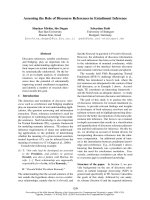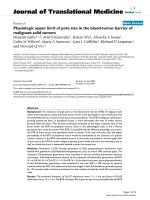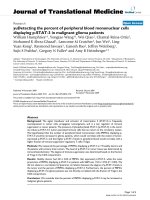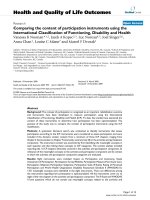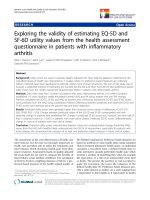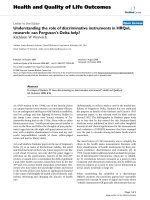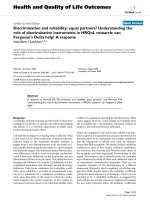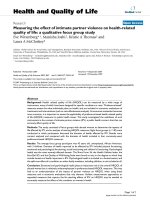báo cáo hóa học: " Understanding the role of discriminative instruments in HRQoL research: can Ferguson''''s Delta help?" docx
Bạn đang xem bản rút gọn của tài liệu. Xem và tải ngay bản đầy đủ của tài liệu tại đây (170.48 KB, 2 trang )
BioMed Central
Page 1 of 2
(page number not for citation purposes)
Health and Quality of Life Outcomes
Open Access
Letter to the Editor
Understanding the role of discriminative instruments in HRQoL
research: can Ferguson's Delta help?
Kathleen W Wyrwich
Address: Senior Research Scientist, United BioSource Corporation, Bethesda, MD, USA
Email: Kathleen W Wyrwich -
Abstract
A critique of Hankins, M: How discriminating are discriminative instruments?" Health and Quality of
Life Outcomes 2008, 6:36
As a PhD student in the 1990s, one of my favorite places
on campus was the Lewis Annex to our university's library.
It is an underground shelf space with limited accessibility,
very low ceilings and dim lighting. However, hidden in
the damp Lewis Annex were bound volumes of Psy-
chometrika dating back to the 1930s. Alone with no other
library patrons near, I could spread open several articles at
once on the floor and follow the thoughts of past psycho-
metric sages late into the night with great interest and con-
tent, with complete abandonment of time and my real-
world responsibilities outside of those yellow-paged
tomes and narrow library aisles.
As I read Matthew Hankins' paper on the use of Ferguson's
Delta [1] as an index of discriminate validity, the smell
and fond memories of the Lewis Annex swept over me like
a soft cloud. However, not only did this paper trigger a
reflection on the psychometric masters of the mid 20
th
century, it caused me to contemplate the debt of gratitude
I and other health outcomes researchers have to the late
20
th
and 21st century health researchers at McMaster Uni-
versity who have taken the knowledge written and stored
in the bowels of the Lewis Annex to applications featured
in the center of all brightly-lit health science libraries, and,
indeed, informing and changing the practice of health
care.
Unfortunately, in order to make a case for the needed use-
fulness of Ferguson's Delta, Hankins has not embraced
the purpose or details of the Kirshner and Guyatt's 1985
taxonomy paper, or the relevant work by these authors
beyond 1992. The bibliography in Hankins' paper leads
me to fear that he has missed the rich Evidence-Based
Medicine series published in JAMA and other insightful
theoretical and clinical applications for the measurement
and evaluation of HRQOL measures that have emerged
over the past 3+ decades among McMaster heath science
researchers.
The stated intent of 1985 taxonomy was to simplify the
chaos in the health status measurement literature with
three classifications of health instruments by their pur-
poses: predictive, discriminative and evaluative [2]. In
1995, Guyatt further addressed and elucidated the proper-
ties of discriminative instruments, which are: 1) reliabil-
ity; 2) correlations between measures as a point in time
consistent with theoretical predictions; and 3) differences
between subjects at a point in time can be interpreted as
trivial, small, moderate or large [3].
When considering the reliability of a discriminate
HRQOL measure, the taxonomy papers have repeatedly
stressed this concept in terms of signal and noise where
"reliable instruments will generally demonstrate that sta-
Published: 16 October 2008
Health and Quality of Life Outcomes 2008, 6:82 doi:10.1186/1477-7525-6-82
Received: 5 August 2008
Accepted: 16 October 2008
This article is available from: />© 2008 Wyrwich; licensee BioMed Central Ltd.
This is an Open Access article distributed under the terms of the Creative Commons Attribution License ( />),
which permits unrestricted use, distribution, and reproduction in any medium, provided the original work is properly cited.
Publish with BioMed Central and every
scientist can read your work free of charge
"BioMed Central will be the most significant development for
disseminating the results of biomedical research in our lifetime."
Sir Paul Nurse, Cancer Research UK
Your research papers will be:
available free of charge to the entire biomedical community
peer reviewed and published immediately upon acceptance
cited in PubMed and archived on PubMed Central
yours — you keep the copyright
Submit your manuscript here:
/>BioMedcentral
Health and Quality of Life Outcomes 2008, 6:82 />Page 2 of 2
(page number not for citation purposes)
ble subjects show more or less the same results on
repeated administrations." p. 1188 [3] In the HRQOL lit-
erature, this is commonly referred to as test-retest reliabil-
ity. Yet in none of the Hankins examples is this type of
reliability calculated or reported. The first example uses an
intraclass correlation between two different measures as
the estimate of reliability, while the second and third
examples use Cronbach's alpha to judge reliability. Both
of these methods for estimating reliability are inappropri-
ate for assessing this property of discriminative measures,
as described by Kirshner and Guyatt [4].
The second property of a discriminative instrument is a
cross sectional relationship with a theoretical criterion or
prediction, and again, in none of the examples offered by
Hankins do we see this very important property demon-
strated. We are told in Example 1 that the two measures
being compared are "equally valid," but no explanation is
given to allow the reader to know the basis of this validity
assessment. Moreover, no results on the relationship of
the reported measures or items in Example 2 and 3 are
provided.
Likewise, the third and perhaps most important property
that the McMaster group has endorsed for discriminative
instruments is interpretability so that small but important
cross sectional differences between subjects are distin-
guishable. This property is not addressed in the Hankins'
paper, and there is no explanation for how the use of Fer-
guson's Delta would enhance interpretability.
Although the use of Ferguson's Delta may someday
improve our understanding of discriminative measures
and their development, the examples supplied in this
paper do not allow us to currently make this judgment.
Hankins' prior published work applying Ferguson's Delta
to identify the discrimination of dichotomous vs. 4-point
Likert scaled GHQ-12 items gave results that are well-
expected; Likert response items (if chosen correctly) are
more discriminating between individuals than dichoto-
mous items [1]. It is important to note that Guyatt, Kirsner
and Jaeschke expressed that the "evidence for the success
[of their taxonomy] would be the students' ability to
manipulate concepts and to produce higher quality
research from a sound conceptual basis." p. 1353 [5]
Hence, we look forward to seeing relevant demonstration
of the usefulness of this novel psychometric method in
HRQOL research that fully encompasses the intent of the
taxonomy, integrates the relevant properties described
above, and reflects the McMaster authors' goal for evi-
dence of its of success.
Competing interests
The author declares that she has no competing interests.
References
1. Hankins M: How discriminating are discriminative instru-
ments? Health and quality of life outcomes 2008, 6(1):36.
2. Kirshner B, Guyatt G: A methodological framework for assess-
ing health indices. Journal of chronic diseases 1985, 38(1):27-36.
3. Guyatt GH: A taxonomy of health status instruments. The Jour-
nal of rheumatology 1995, 22(6):1188-1190.
4. Streiner DL, Norman GR: Health measurement scales: A practical guide
to their development and use 4th edition. Oxford: Oxford University;
2008 in press.
5. Guyatt GH, Kirshner B, Jaeschke R: A methodologic framework
for health status measures: clarity or oversimplification?
Journal of clinical epidemiology 1992, 45(12):1353-1355.
